When it comes to selecting a tennis racket, you have hundreds of options to choose from, which can be very daunting, especially if you are new to tennis.
Using the below guide will help you to understand what you should look for when buying a racket such as head size, strung weight, swing weight, string pattern, grip size, balance, stiffness, and beam width.
I will also give you my top 5 picks for the best tennis rackets for beginners, intermediate, and advanced players.
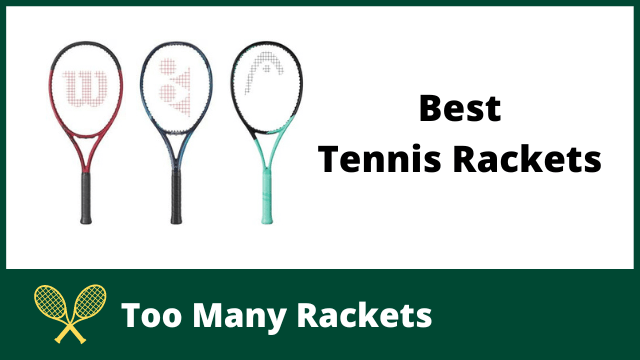
My Picks for the Best Tennis Rackets in 2024
If you just want to find out which are the best rackets to choose for your skill level, then you can use the below links to jump to my top 5 picks for beginners, Intermediate, or advanced tennis players in 2024.
In my opinion, the best overall tennis racket for 2024 is the Babolat Pure Aero as it is a good all round racket that suits a wide range of skill levels and playing styles.
Beginners
Intermediate
Advanced
What to look for when buying a tennis racket
Head Size
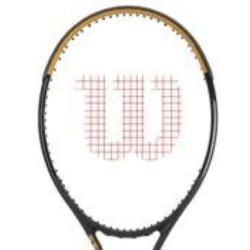
Head sizes range from as small as 80 sq inches to as large as 130 square inches but most modern frames will have a 98 to 100 head size.
Generally speaking, a larger head size will give you a bigger sweet spot and more power so beginners often will opt to buy an oversized frame with a larger head size so that it is easier for them to hit the sweet spot and generate pace.
NB: Oversized rackets have a head size of 105 sq inches or greater.
However, the downside to using an oversized frame is that although you get plenty of power, this comes at the cost of control.
As your game improves you will likely want to buy a frame with a head size between 95 and 104 sq inches as this is more suited to intermediate players and will give you a better balance between power and control.
Frames with a head size of less than 95 sq inches aren’t used that much anymore as they have a very small sweet spot and generally speaking, should be avoided by most recreational tennis players.
So for the vast majority of recreational players, it will be a decision between a 98 and a 100 inch head size.
If you are looking for more control and you have a one handed backhand then I would recommend a 98-inch head size but if you need some help with power and you want a more forgiving frame then you should go with a 100-inch head size.
Weight
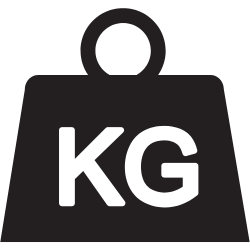
What weight your racket should be, depends on the level you are currently playing at.
If you are a beginner then you should go with a lighter frame as this will be easier to swing and will help you generate more power, with lighter weight frames usually weighing between 270g to 300g unstrung.
Intermediate players who have started to develop a full swing will usually opt for a slightly heavier frame in the 300g to 320g range, while more advanced players usually prefer heavier frames that are between 320g and 360g.
If you are a beginner, then you should avoid frames heavier than 300g unstrung, for example, Roger Federer’s RF97 should not be used by beginners, as a heavy frame like this, will not help you play better and is more likely to slow your improvement.
Swing Weight
In simple terms the higher the swing weight of a tennis racket the harder it is to swing.
A lower swing weight will help you generate spin whereas a higher swing weight will give you more power and stability on your shots.
If you play lots of doubles or if you have a one handed backhand then I would recommend going for a frame with a medium to high swing weight as this will give you the stability you need on your backhand and on your volleys.
If you are a tennis beginner, then it is best to stick to options with a low swing weight until you improve to a level where you are hitting balls with a full swing.
String Pattern
Put simply a tennis racket’s string pattern is the ratio between the number of vertical strings (called main strings) to the number of horizontal strings (called cross strings) on a racket.
There are several string patterns available with the most popular being the 16 x 19 and 18 x 20 string patterns.
A 16×19 string pattern will give you more spin on your shots whereas an 18×20 string pattern will give you more control.
There is no right or wrong option when it comes down to the string pattern you choose and it will usually come down to what you want from your sting pattern i.e., more spin or more control.
Grip Size
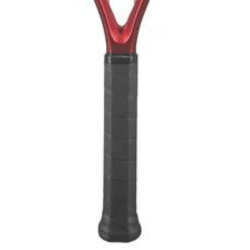
Grip sizes range from 4 inches to 4 5/8 inches, with the average grip size being 4 and 1/8 for adult female players and 4 1/2 for adult male players.
Grip size is often overlooked when buying a racket, but getting the wrong grip size can greatly impact your game.
Check out this Grip Sizes Guide and Chart for more information on how to work out what grip size is right for you.
Balance (Head Light vs Head Heavy)
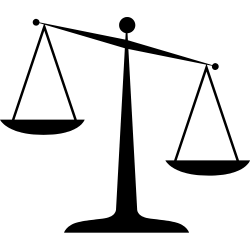
The balance of a tennis racket refers to where most of the weight is included and deciding between a Head Light vs Head Heavy can have a big impact on the playability of a racket
If most of the weight is included in the head, it is considered to have a head heavy balance (HH), whereas if most of the weight is in the handle, it is considered to have a head light balance (HL).
Most tennis rackets are either head heavy or head light but there are some, where the weight has been evenly distributed around the frame and handle, with these rackets being referred to as evenly balanced rackets.
Head light frames are generally easier to swing than head heavy frames and you will find that most tennis pros play with a head light frame.
However, head heavy frames will give you more power as there will be more mass behind the ball.
For this reason, head heavy frames are usually used by beginners who need help generating power.
However, the extra power you get with a head heavy frames comes at the cost of control.
If you are a beginner and you want to play lots of doubles then I would recommend a racket with a head light balance whereas if you plan to mainly play singles then a head heavy balance will be the better option.
However, as you improve your skills, you will likely gravitate towards head light tennis rackets.
NB: I have included a table of racket balance points for your reference below.
Tennis Racket Balance Points
| Points | cm (rounded) | mm (rounded) | Inches (rounded) |
|---|---|---|---|
| 10 Points HH | 37.5cm | 375mm | 14.8in |
| 9 Points HH | 37.2cm | 372mm | 14.6in |
| 8 Points HH | 36.8cm | 368mm | 14.5in |
| 7 Points HH | 36.5cm | 365mm | 14.4in |
| 6 Points HH | 36.2cm | 362mm | 14.3in |
| 5 Points HH | 35.9cm | 359mm | 14.1in |
| 4 Points HH | 35.6cm | 356mm | 14.0in |
| 3 Points HH | 35.2cm | 352mm | 13.9in |
| 2 Points HH | 34.9cm | 349mm | 13.8in |
| 1 Point HH | 34.6cm | 346mm | 13.6in |
| Even Balance | 34.3cm | 343mm | 13.5in |
| 1 Point HL | 34.0cm | 340mm | 13.4in |
| 2 Pts HL | 33.7cm | 337mm | 13.3in |
| 3 Pts HL | 33.4cm | 334mm | 13.1in |
| 4 Pts HL | 33.0cm | 330mm | 13.0in |
| 5 Pts HL | 32.7cm | 327mm | 12.9in |
| 6 Pts HL | 32.4cm | 324mm | 12.8in |
| 7 Pts HL | 32.1cm | 321mm | 12.6in |
| 8 Pts HL | 31.8cm | 318mm | 12.5in |
| 9 Pts HL | 31.4cm | 314mm | 12.4in |
| 10 Pts HL | 31.1cm | 311mm | 12.3in |
| 11 Pts HL | 30.8cm | 308mm | 12.1in |
| 12 Pts HL | 30.5cm | 305mm | 12.0in |
Frame Stiffness
Frame Stiffness is measured on a scale from 0 – 100 with most rackets falling in the 50-80 stiffness range.
The stiffness rating of a frame is one of the key things you should look at if you have had arm issues or tennis elbow in the past.
A frame with a high stiffness rating will give you lots of power but it is more likely that you will encounter some arm issues if you regularly play with a frame with a high stiffness rating.
If you are looking for an arm friendly option then I recommend going for a frame with a stiffness rating in the low 60s or below.
A good example of an arm friendly option would be the Wilson Clash 98 V1 which has a stiffness rating of 55.
Beam Width
The average beam width of a modern tennis racket is 23mm with rackets below this being considered to have a narrow beam and rackets above this being considered to have a wide beam.
Generally speaking, a wider beam will give you more power but this will come at the cost of less maneuverability and control.
You will find that tennis rackets for beginners will tend to have a wider beam whereas rackets used by more advanced players will have a narrow beam.
Best Tennis Rackets by Skill Level
Below are my top 5 picks for beginner, intermediate, and advanced tennis players.
NB: If you purchase a racket after clicking one of the buttons below you will be helping to support my blog as I will earn a small commission from the sale at no additional cost to you.
Best Tennis Rackets for Beginners
1. Babolat Pure Drive Lite
The Babolat Pure Drive Lite offers good power without sacrificing too much control and is my top recommended racket for players who are just starting tennis.
It also has a very manageable swing and strung weight (both under 300g) which makes it ideal for beginners.
| Version: | 2021 |
| Design: | 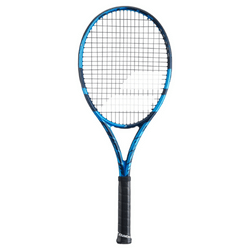 |
| Head Size: | 100in² |
| Length: | 27in |
| Strung Weight: | 283g (9.98oz) |
| Balance: | 1 pts HL |
| Swing Weight: | 299 |
| String Pattern: | 16 x 19 |
| Beam Width: | 23mm / 26mm / 23mm |
| Stiffness Rating: | 69 |
2. Head TI S6
The Head TI S6 has a 115 inch head size and a 27.75 inch racket length, which gives you tons of free power and is a good option if you have never played tennis before and you want to buy a very forgiving racket.
| Version: | 2007 |
| Design: | 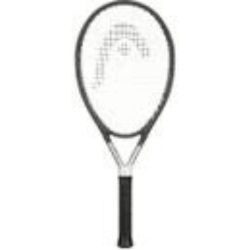 |
| Head Size: | 115in² |
| Length: | 27.75in |
| Strung Weight: | 252g (8.90oz) |
| Balance: | 8 pts HH |
| Swing Weight: | 318 |
| String Pattern: | 16 x 19 |
| Beam Width: | 27mm-28mm |
| Stiffness Rating: | 75 |
3. HEAD Graphene XT Radical S
The HEAD Graphene XT Radical S is a solid option if you are looking for a racket that offers good power and spin while having a relatively low stiffness rating (60).
| Version: | 2016 |
| Design: | 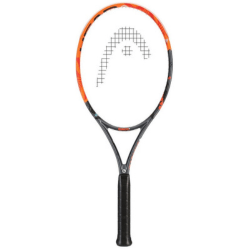 |
| Head Size: | 102in² |
| Length: | 27in |
| Strung Weight: | 295g (10.4oz) |
| Balance: | 4 pts HL |
| Swing Weight: | 301 |
| String Pattern: | 16 x 19 |
| Beam Width: | 22mm / 25mm / 23mm |
| Stiffness Rating: | 60 |
4. Wilson Clash 108
The Wilson Clash 108 is a lightweight frame that has a large sweet spot, is very forgiving, and is very comfortable to play with due to its low stiffness rating (63).
| Version: | 2022 (V2) |
| Design: | 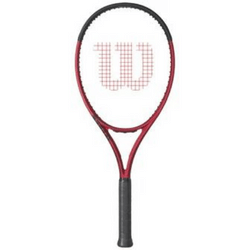 |
| Head Size: | 108in² |
| Length: | 27.25in |
| Strung Weight: | 295g (10.4oz) |
| Balance: | Even Balance |
| Swing Weight: | 325 |
| String Pattern: | 16 x 19 |
| Beam Width: | 24.5mm |
| Stiffness Rating: | 63 |
5. Yonex Ezone 100L
The Yonex Ezone 100L is a good option for players looking for a beginner friendly racket that has a good balance between power, control, and spin.
| Version: | 2022 |
| Design: | 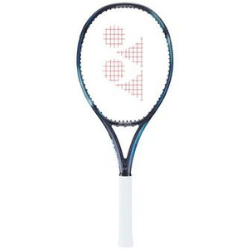 |
| Head Size: | 100in² |
| Length: | 27in |
| Strung Weight: | 298g (10.5oz) |
| Balance: | 3 pts HL |
| Swing Weight: | 308 |
| String Pattern: | 16 x 19 |
| Beam Width: | 23.8mm / 26.5mm / 22.5mm |
| Stiffness Rating: | 69 |
Best Tennis Rackets for Intermediate Players
1. Babolat Pure Drive
The Babolat Pure Drive is my number 1 recommendation for an intermediate racket as it gives an excellent balance between power and control.
The Babolat Pure Drive is also very popular on the doubles pro tour with players like Bob and Mike Bryan using the plus version of the racket.
| Version: | 2021 |
| Design: |  |
| Head Size: | 100in² |
| Length: | 27in |
| Strung Weight: | 318g (11.22oz) |
| Balance: | 4 pts HL |
| Swing Weight: | 320 |
| String Pattern: | 16 x 19 |
| Beam Width: | 23mm / 26mm / 23mm |
| Stiffness Rating: | 71 |
2. Head Boom MP
The Head Boom MP is endorsed by Coco Gauff and is an excellent option for intermediate players looking for control and spin.
| Version: | V1 |
| Design: | 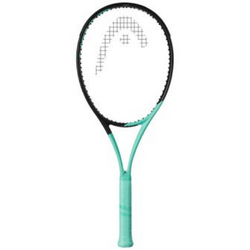 |
| Head Size: | 100in² |
| Length: | 27in |
| Strung Weight: | 315g (11.1oz) |
| Balance: | 5 pts HL |
| Swing Weight: | 318 |
| String Pattern: | 16 x 19 |
| Beam Width: | 23.5mm / 24.5mm / 23.5mm |
| Stiffness Rating: | 64 |
3. Wilson Clash 100
The Wilson Clash 100 is one of the top-selling rackets on the market today, with its main selling point being the fact that it is very comfortable to play with and is a good option for players who have had tennis elbow or arm issues in the past.
| Version: | V2 |
| Design: | 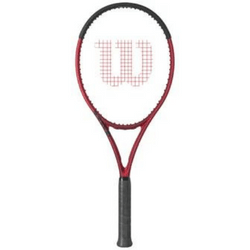 |
| Head Size: | 100in² |
| Length: | 27in |
| Strung Weight: | 312g (11.0oz) |
| Balance: | 7 pts HL |
| Swing Weight: | 133 |
| String Pattern: | 16 x 19 |
| Beam Width: | 24.5mm |
| Stiffness Rating: | 57 |
4. Wilson Ultra 100
The Wilson Ultra 100 is a more old-style racket that has a fairly high stiffness rating of 70 but offers tons of free power on your groundstrokes and serves.
| Version: | V4 |
| Design: | 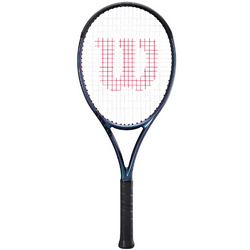 |
| Head Size: | 100in² |
| Length: | 27in |
| Strung Weight: | 318g (11.2oz) |
| Balance: | 4 pts HL |
| Swing Weight: | 317 |
| String Pattern: | 16 x 19 |
| Beam Width: | 24mm / 26.5mm / 25mm |
| Stiffness Rating: | 70 |
5. Yonex Ezone 100
The Yonex Ezone 100 is endorsed by several top pros including Belinda Bencic, Casper Ruud, and Sorana Cirstea, and is a good option for players looking for a little help in terms of power.
| Version: | 2022 |
| Design: | 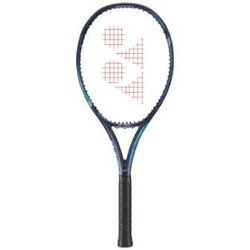 |
| Head Size: | 100in² |
| Length: | 27in |
| Strung Weight: | 318g (11.2oz) |
| Balance: | 4 pts HL |
| Swing Weight: | 317 |
| String Pattern: | 16 x 19 |
| Beam Width: | 23.8mm / 26.5mm / 22.5mm |
| Stiffness Rating: | 67 |
Best Tennis Rackets for Advanced Players
1. Babolat Pure Aero
The Babolat Pure Aero is a good all-round racket that will suit several different skill levels and playing styles and is my top pick for best overall tennis racket in 2024.
| Version: | V7 |
| Design: | 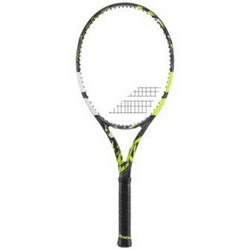 |
| Head Size: | 100in² |
| Length: | 27in |
| Strung Weight: | 318g (11.2oz) |
| Balance: | 4 pts HL |
| Swing Weight: | 322 |
| String Pattern: | 16 x 19 |
| Beam Width: | 23mm / 26mm / 23mm |
| Stiffness Rating: | 65 |
2. Head Gravity Pro
The Head Gravity Pro has a relatively high strung/swing weight and an 18 x 20 string pattern which means you will get plenty of control and stability with this frame.
| Version: | 2023 |
| Design: | 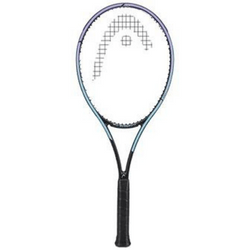 |
| Head Size: | 100in² |
| Length: | 27in |
| Strung Weight: | 332g (11.7oz) |
| Balance: | 6 pts HL |
| Swing Weight: | 334 |
| String Pattern: | 18 x 20 |
| Beam Width: | 20mm |
| Stiffness Rating: | 63 |
3. Wilson Blade 98
The Wilson Blade 98 is a great option for advanced players who want tons of control and can generate their own power.
The Blade 98 comes in two versions (16 x 19 and 18 x 20), with the 18 x 20 version providing more control and the 16 x 19 providing more spin.
| Version: | V8 |
| Design: | 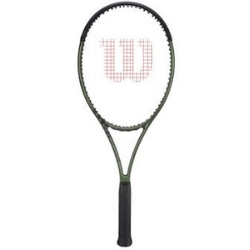 |
| Head Size: | 98in² |
| Length: | 27in |
| Strung Weight: | 320g (11.3oz) |
| Balance: | 4 pts HL |
| Swing Weight: | 317 |
| String Pattern: | 16 x 19 or 18 x 20 |
| Beam Width: | 21.0mm |
| Stiffness Rating: | 61 |
4. Wilson Pro Staff RF97 Autograph
If you are an advanced player, the Wilson Pro Staff RF97 Autograph is the best tennis racket you can get for your one handed backhand.
It offers excellent plow through on your backhand and provides great feel and control on your slices, volleys, and drop shots.
| Version: | V13 |
| Design: | 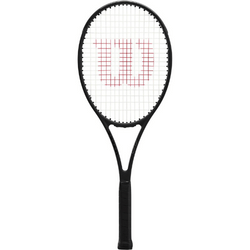 |
| Head Size: | 97in² |
| Length: | 27in |
| Strung Weight: | 357g (12.5oz) |
| Balance: | 7 pts HL |
| Swing Weight: | 333 |
| String Pattern: | 16 x 19 |
| Beam Width: | 21.5mm |
| Stiffness Rating: | 68 |
5. Yonex Ezone 98
The Yonex Ezone 98 is a solid frame that gives you a little more help with power than the other advanced rackets on this list.
| Version: | 2022 |
| Design: | 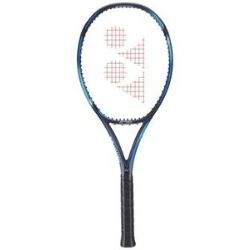 |
| Head Size: | 98in² |
| Length: | 27in |
| Strung Weight: | 323g (11.4oz) |
| Balance: | 6 pts HL |
| Swing Weight: | 318 |
| String Pattern: | 16 x 19 |
| Beam Width: | 23.5mm / 24.5mm / 19.5mm |
| Stiffness Rating: | 65 |